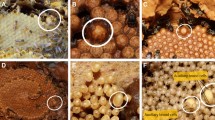Summary.
Anarchistic honey bees are a line developed by recurrent selection in which workers frequently lay eggs. In unselected colonies, workers refrain from reproduction in response to pheromonal signals that indicate the presence of brood and a queen. We show that queen type (anarchistic or wild type) has no effect on rates of ovary activation of anarchistic or wild type workers. In addition, we show that an important component of the queen’s signalling system, the queen mandibular gland pheromone, is similar in wild type and anarchistic queens. Anarchistic larvae do not inhibit worker ovary development to the same degree as wild type larvae, however all colonies in this experiment contained only wild type larvae. Anarchistic workers had greater rates of ovary activation than wild type workers in colonies headed by either queen type. We therefore conclude that there must be differences in the transmission or reception of queen pheromones, or worker sensitivity to these compounds. These results clearly demonstrate that anarchy is a complex syndrome, not simply the result of reduced pheromone production by anarchist queens and larvae.
Similar content being viewed by others
Author information
Authors and Affiliations
Corresponding author
Additional information
Received 23 December 2003; revised 14 May 2004; accepted 1 June 2004.
Rights and permissions
About this article
Cite this article
Hoover, S.E.R., Oldroyd, B.P., Wossler, T.C. et al. Anarchistic queen honey bees have normal queen mandibular pheromones. Insectes Soc. 52, 6–10 (2005). https://doi.org/10.1007/s00040-004-0772-y
Issue Date:
DOI: https://doi.org/10.1007/s00040-004-0772-y




